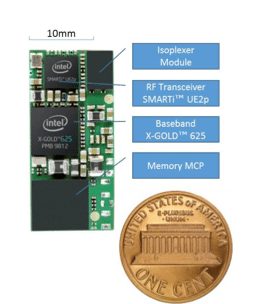Intel has struggled to find its footing with mobile processors, but the chip giant is determined to make headway in the mobile connectivity market. Its modem family has a new member in the XMM6255, which Intel calls the world’s smallest standalone 3G modem. Rather than tablets or smartphones the XMM6255 is targeting the Internet of Things. The company says its market research showed that 3G was the right choice now for IoT.
“We picked 3G intentionally. We believe that this is exactly what the market wants. We will have LTE IoT dedicated devices in the future,” said Stefan Wolff, VP of Intel’s platform engineering group. “3G is the sweet spot for the launch of the Internet of Things technology in the next 24 months.” Wolff also noted that a 3G modem is more affordable than an LTE modem and does not need to support as many bands.
“The throughput requirements from the data traffic we expect from our markets and our customers are way below LTE capabilities. So this 7.2 megabits per second should be more than enough for the applications which are currently in use,” said Wolff. He added that some solutions which target consumers are not appropriate markets for Intel’s new device.
“I am not talking about video streaming in the smartwatch,” said Wolff. “That is for me not an Internet of Things device. We are also not talking about automotive. You certainly need LTE in the car, there is no debate about that. But IoT is more than video wearables and automotive. In particular, industrial, metering, all control, measurement, data collection activities are well covered with the capabilities of a 3G device.” Energy management, environmental measurement, and all types of metering are target markets for Intel’s new modem.
Intel says that every second, 80 new things connect to the Internet. For most of the companies that make products which are connecting for the first time, price and footprint are probably more important than the speed of the connection. With those considerations in mind, Intel has co-architected the power amplifier and the transceiver, and integrated them onto the same board with the modem.

Intel has big plans for tiny modem
ABOUT AUTHOR
